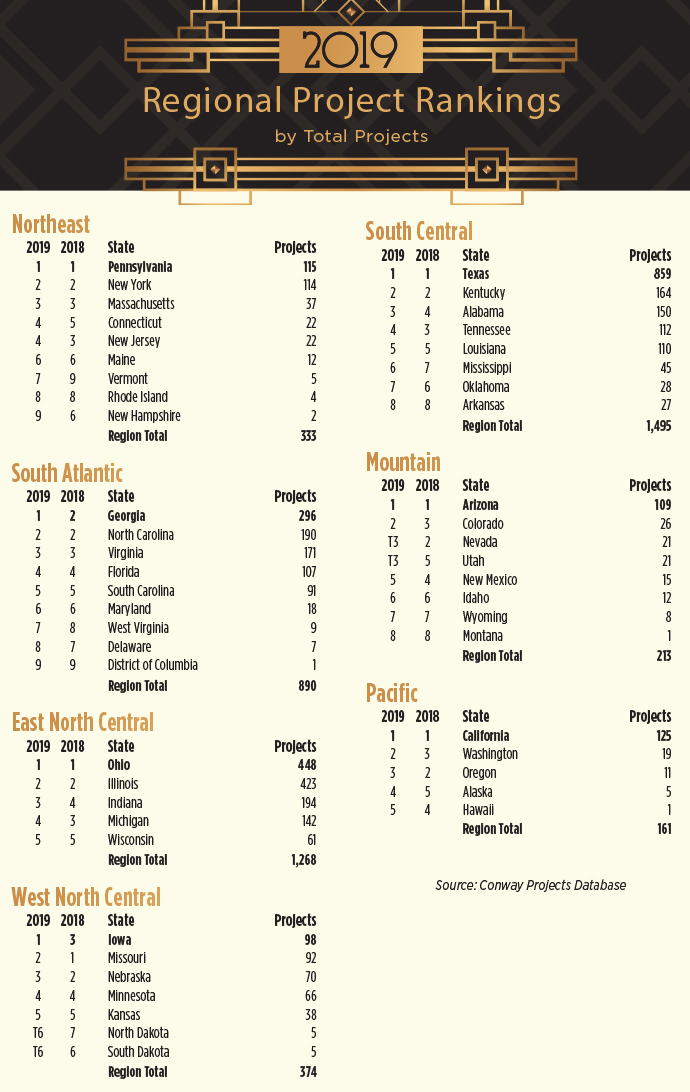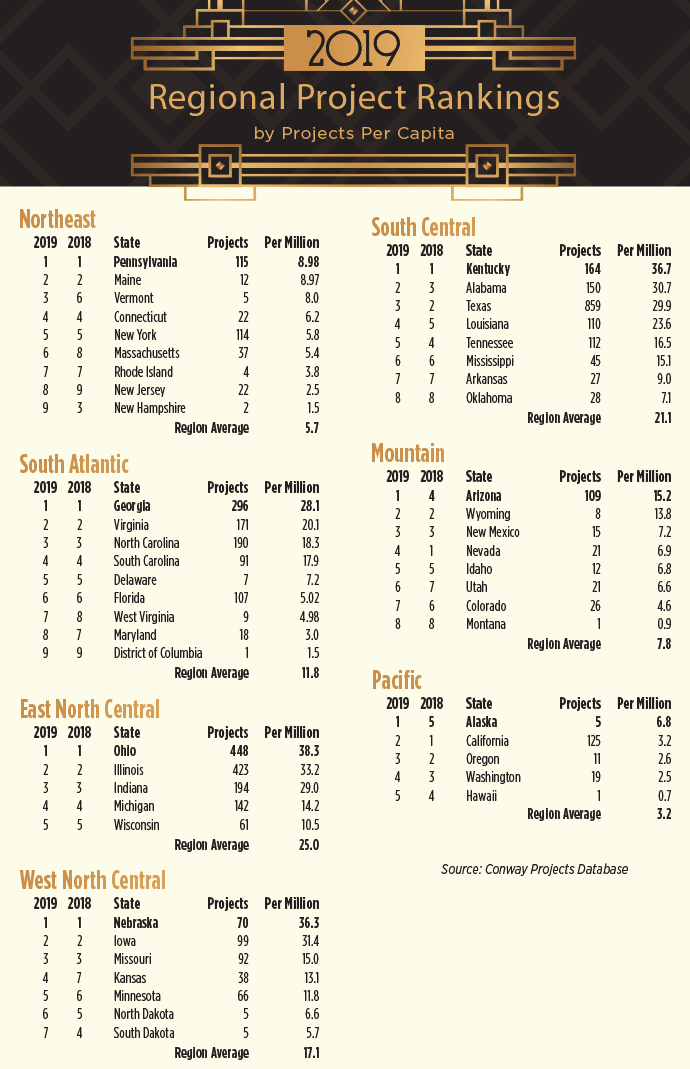March in the economic development world means it’s time to see who won the U.S. facilities races for capital investment projects the previous year. The Governor’s Cup for total qualifying projects goes — for the eighth consecutive year — to Texas and to Governor Greg Abbott specifically. The Lone Star State is loath to give up that recognition, it seems. But its booming and diverse economy, driven by the energy, IT, aerospace and automotive industries among others, makes it hard to beat. Its total of 859 projects is very hard to beat. Second-place Ohio has 448, followed by Illinois (423), Georgia (296) and Indiana (194) to round out the top five.
The Governor’s Cup for total projects per capita this year goes to Ohio and its governor, Mike DeWine. The Buckeye State was a frequent second-place finisher in both categories in recent years; it unseats Nebraska, which claimed the per capita Cup for the past three years. Following Ohio in the per capita contest are Kentucky (164), Nebraska (70), Illinois and Iowa (98).
Qualifying projects are those meeting one or more of Site Selection’s criteria for inclusion in the Conway Projects Database: a minimum investment of $1 million, creation of 20 or more new jobs or 20,000 square feet or more of new space.
Both Governors DeWine and Abbott are quick to share the credit for their states’ wins with their state economic development teams and with the economic development professionals in the regions, cities and towns that work tirelessly to bring business and industry to their communities. They know that a high number of projects, especially high enough to win a Governor’s Cup, is great, but not as great as the thousands of new jobs they represent once those projects come online.

Imagine coaching a team that doesn’t rely on just one or two players to score — every player scores. That’s what being governor of Ohio is like when it comes to competing for new facilities and expansions. From the big metros of Columbus, Cincinnati, Dayton and Cleveland to the micropolitans (10,000 to 50,000 population) like Findlay, Fremont and Defiance, Ohio racks up the project points from one end of the state to the other.
“We’re not just relying on one or two cities. A lot of good things are happening east, west, north and south in Ohio,” says Gov. DeWine. “Every player on our team can score. We have a lot of cities and towns and regions that can score. Underlying everything is the strong work ethic. One of the things that I find when I talk to international or national companies is that they really like our workforce. They’re Midwesterners — they get up in the morning to go to work.”
“WE’RE NOT JUST RELYING ON ONE OR TWO CITIES. EVERY PLAYER ON OUR TEAM CAN SCORE.”
The governor also points to JobsOhio, the state’s private, nonprofit corporation tasked with attracting capital investment, as a highly effective contributor to Ohio’s success.
“It’s a competitive advantage that we believe gives us a much more flexible and nimble and quick ability to adapt and to respond to what the needs of businesses are that are looking to expand in Ohio, or businesses that are looking to come to Ohio,” he explains.
Never Mind the Scoreboard
J.P. Nauseef is president and chief investment officer at JobsOhio, and the first point he makes in an interview with Site Selection is the breadth and skill inherent in the state’s economic development team. “The Governor’s Cup is a testament to the team — the JobsOhio team, the regional and local economic development partners that are part of the network, the administration and the legislature for putting the business climate in place,” he says. “We’re going to keep moving forward and not really look at the scoreboard but look forward to sharing the message about Ohio, which is beginning to resonate more and more.”
Nauseef says Ohio’s winning performance can be attributed to several factors.
“We have a talented and abundant workforce,” he relates. “We have a diverse set of communities, a healthy mix of reasonably sized cities and smaller towns. The infrastructure is such that if you are interested in living in a small town you can live there and have a 20- to 30-minute commute into one of the larger cities. From an economic development perspective, the legislature and previous administration privatized the Department of Development, which has many advantages, but it created a stable funding platform.” JobsOhio is fully funded by profits from the JobsOhio Beverage System (JOBS) liquor enterprise — not from taxes paid on liquor sales.
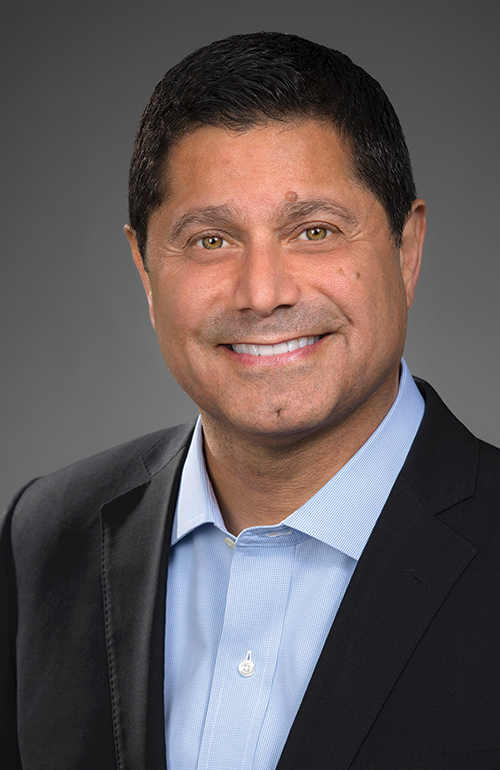
“WE’RE GOING TO KEEP MOVING FORWARD AND NOT REALLY LOOK AT THE SCOREBOARD BUT LOOK FORWARD TO SHARING THE MESSAGE ABOUT OHIO, WHICH IS BEGINNING TO RESONATE MORE AND MORE.”
JobsOhio explains: “JOBS liquor profits provide a stable funding source for economic development in Ohio, and JobsOhio has proved its effectiveness in using these funds and making smart investments to fulfill its mission. Also, this allows JobsOhio to utilize a longer-term horizon for funding economic development activities, giving JobsOhio a competitive advantage over other state development organizations.”
It’s well-funded, but JobsOhio is hardly about “throwing money at deals,” says Nauseef. “It’s about being able to plan and bring in people from the industries that we’re actually negotiating with and communicating with and recruiting and expanding. We’re able to pull professionals from those industries and offer them an alternative path where they can do something that’s got a broader mission of helping their fellow citizens. They can put all their experience from industry to use, and we can offer them a path to do that because of the stability of funding. We can also provide resources because of that funding to move very quickly to put a deal on the table that’s a good deal for Ohio — a deal that makes sense and creates a return for Ohio citizens.
“Third,” Nauseef continues, “because of the way we’re organized, we go to market across this diverse state through regional and local partners. We [ensure] privacy so we can negotiate, and private-sector companies can know that we will not share their information. We do that with resources and people that understand the language of these companies. We can go into the marketplace to these regional partners with a local touch, because those regional economic development organizations and local economic development professionals know their communities really well.”
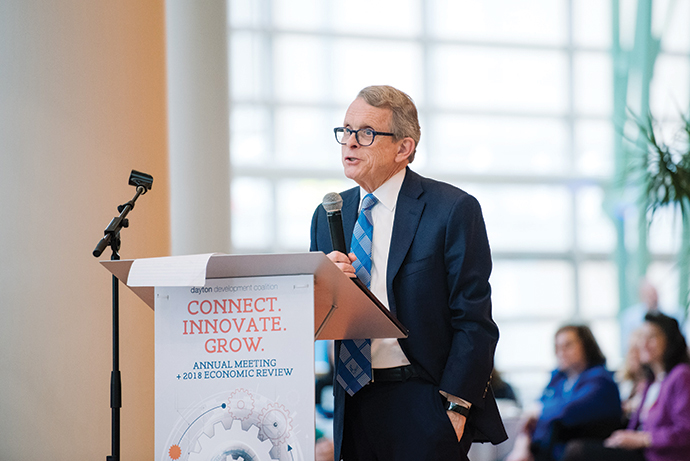
The Governor’s on the Phone
What’s the role of the governor in closing deals? Site Selection asked Governor DeWine that question — an obvious one, perhaps, in the context of a Governor’s Cup win.
“I was in the U.S. Senate, and I continue to tell my team as governor, there are certain calls that only the boss can make,” he replies. “The key for the team is to identify when those calls need to be made. Within the last year, we had a situation that really could have gone to another state. It was my personal involvement in assuring the CEO that we’re in this, we want to help you now. But we also want to help you in the long run.
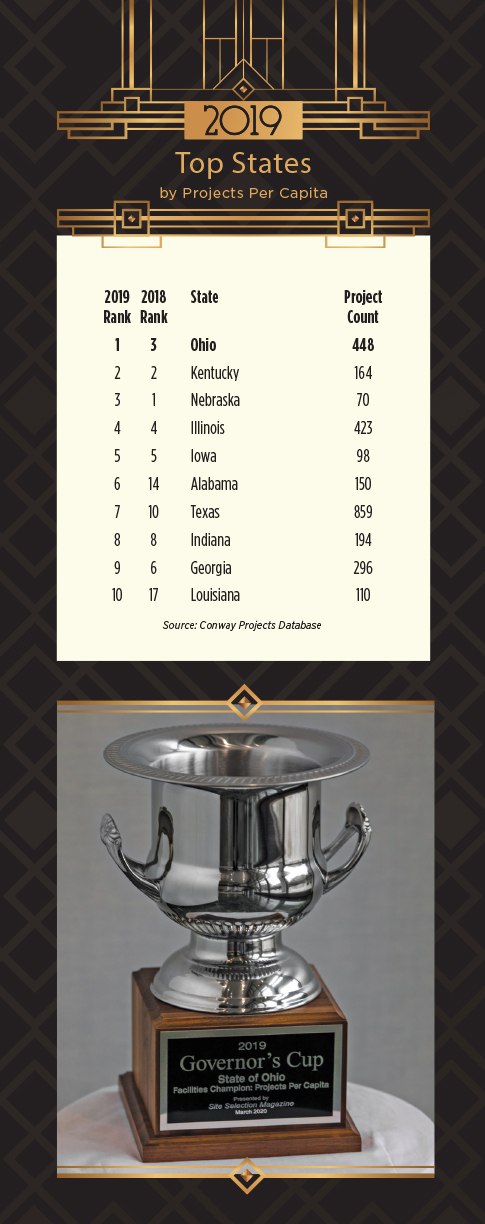
“Any time we’re talking to a company about expanding in or coming to Ohio, while the local communities are involved,” continues the governor, “it’s my ability to reach out to a mayor and pull in whoever has to be pulled in locally and say, ‘Okay, here’s our problem. This company’s got this challenge. We need to work to help them.’ The governor is someone who can pull people together.”
More than a few people were pulled together in 2019 prior to General Motors and LG Chem announcing on December 5 an 1,100-job plant in the Lordstown area focused on the mass production of battery cells for future battery-electric vehicles. GM has made clear that this technology will be a cornerstone for its business model moving forward. The company previously announced it will develop 20 electric models to sell worldwide by 2023. The announcement represents an investment of up to $2.3 billion through the new, equally owned joint venture company.
In November 2018, GM announced a restructuring that resulted in the closure of their Lordstown, Ohio factory. Since then, the DeWine-Husted Administration, together with JobsOhio, has pressed General Motors to make a renewed commitment to the state.
“It is great news for Ohio that GM and LG Chem are going to build a new electric battery facility here,” said Ohio Governor DeWine at the project announcement. “Ohio is a major supplier state for the automotive industry, and the announcement that Ohio will be the location to manufacture next-generation electric batteries will mean more than 1,100 new jobs for Ohioans.”
Added J.P. Nauseef: “The joint venture between GM and LG Chem will bring an advanced battery production facility to Ohio that will keep our state at the forefront of the automotive industry as it continues to evolve. This agreement shows confidence in Ohio’s automotive talent, and we are excited to work with GM and LG Chem as they move forward with this project that will bring new high-tech jobs and investment here. It not only reorganizes Ohio’s legacy in the automotive manufacturing, but it indicates the beginning of our bright future in advanced battery production.”

As is his custom, Governor Greg Abbott expressed his gratitude for an eighth consecutive Governor’s Cup in an interview with Site Selection – but just as importantly, “for all the people that we work with across the state. It’s the teamwork and especially the economic development professionals in the different regions that are a tremendous benefit.”
State legislatures play a pivotal role in shaping business climates. Reflecting on the 86th legislature in Austin in 2019, Gov. Abbott is optimistic that even more economic growth is on the way.
“I WON’T SIGN ANY LAW THAT ADDS ANY REGULATION UNLESS IT CUTS TWO REGULATIONS. WE WILL BE FOCUSED ON REGULATORY REDUCTION.”
“One example is the $5 billion that we added for school funding,” he relates. “That also increases teacher pay. It will help us attract and retain the very best teachers, but also invest in strategies that will better educate our students, especially in the early grades. As a result, it will be more attractive for people to relocate to Texas knowing that the schools are going to be improving above the already high quality that is in place. In addition to that, in a related piece of legislation, we also cut property taxes. And we passed a law that limits the ability for those property taxes to be increased in the future, making housing more affordable and making the cost of living and taxes a little bit better.”
Infrastructure funding will remain at about $8 billion annually for the next 10 years, much of which will go to new and improved roads. Which is a good thing, given the influx of companies and residents. “Texas is the number one destination of people who left California,” notes the governor. “Texas is adding more than 1,000 people each day to our population.”
Trade Bill a Boon for Texas
No state benefits more than Texas from the recently signed USMCA trade agreement, Gov. Abbott points out, citing analysis from economist Ray Perryman, president and CEO of the Perryman Group, an economic research and analysis firm based in Waco. Texas was the top exporting state for the 18th consecutive year in 2019 with more than $330 billion in exports.
“As a major exporting state, Texas would see substantial benefits,” wrote Perryman in a December 27, 2019, Waco Herald Tribune column. “We estimate that for Texas, annual gross product will be a projected $17.6 billion higher and employment 164,700 jobs more under the USMCA. These effects far exceed those in any other state. For California, the second most-impacted state, the USMCA will likely lead to a $6.2 billion boost in gross product and almost 58,700 jobs.”
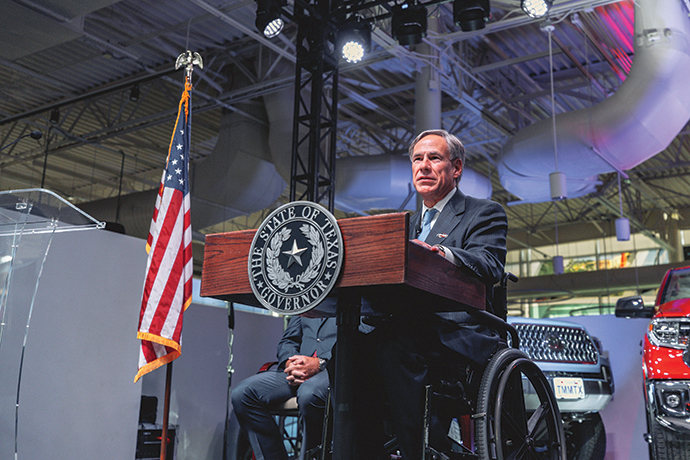
Gov. Abbott attended the ceremonial bill signing of the USMCA in Washington, D.C., on January 29. “Today’s signing of the USMCA trade agreement is a win for the Lone Star State and all of America,” said Governor Abbott at the event. “As the number one exporter in the nation, a strong relationship with our trade partners is vital to Texas’ booming economy and its unprecedented growth. Whether it be agriculture, technology, or energy industries, the USMCA will promote free enterprise and help create even more jobs in the Lone Star State. I thank the Trump administration and the Texas Congressional Delegation for their hard work and persistence to pass this monumental agreement.”
Workforce Commission Gets Marching Orders
In February, Gov. Abbott charged the Tri-Agency Workforce Initiative, consisting of the Commissioners of the Texas Education Agency (TEA), the Texas Higher Education Coordinating Board (THECB), and the Texas Workforce Commission (TWC), to marshal the combined resources of the three agencies to carry forward the reforms adopted by the 86th Legislature through the passage of House Bill 3 and to identify strategies to address long-term workforce development needs across the state. These charges will culminate with a report that will be presented to the Governor by September 1, 2020.
“AS THE NUMBER ONE EXPORTER IN THE NATION, A STRONG RELATIONSHIP WITH OUR TRADE PARTNERS IS VITAL TO TEXAS’ BOOMING ECONOMY AND ITS UNPRECEDENTED GROWTH. ”
“The passage of House Bill 3 marked the most significant transformation of our education system in decades and an unwavering commitment to shaping the future of our workforce,” said Gov. Abbott. “We must continue in our efforts to ensure Texans of all ages have access to high-quality education and workforce skills training that empowers them to achieve their full potential. It is imperative that we build upon the resources of House Bill 3 and accompanying legislation to ensure today’s students and tomorrow’s workforce are prepared to meet Texas’ long-term workforce needs in a comprehensive and efficient manner.”
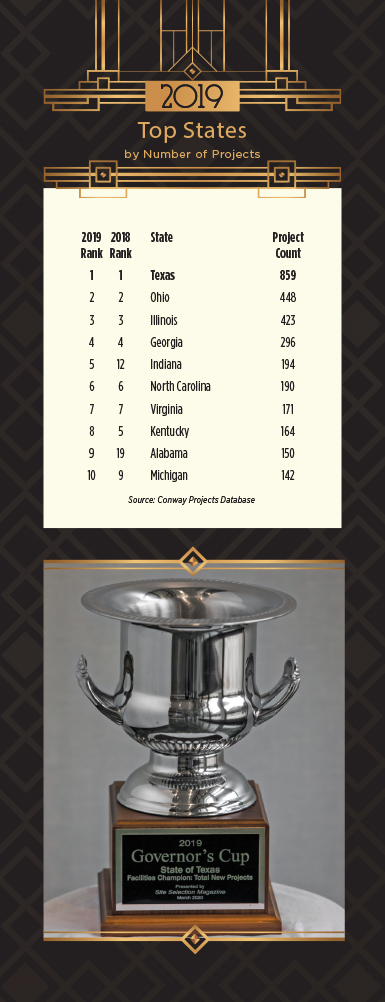
The Governor charged the Commissioners with developing strategies to achieve the following:
- Readiness: The Commissioners should recommend strategies to ensure students are prepared for future growth at each stage in the educational pipeline.
- Completion: The Commissioners should recommend strategies to ensure students who pursue higher education and workforce educational programs can complete those programs in a cost-efficient and timely manner.
- Transitions: The Commissioners should analyze and make recommendations regarding strategies to streamline educational pathways, ensuring students can seamlessly transition into high-wage and high-demand careers.
- Upskilling: The Commissioners should recommend strategies for improving the capacity within the state to produce credentials of value aligned with the needs of high-wage and high-demand occupations.
- Educator Pipeline: The Commissioners should analyze and make recommendations to increase the supply of highly qualified and well-trained individuals entering the teaching profession across the state.
- Partnerships: The Commissioners should explore and recommend options for increasing economic activity in rural Texas, reducing regulatory burdens, and expanding educational partnerships between businesses, school districts, and colleges.
- Infrastructure: The Commissioners should identify strategies to align agency operations, increase program efficiency, improve data analysis and capacity, and to refine 60x30TX, if necessary, to ensure the state’s goals continue to reflect the state’s needs.
The governor established the Tri-Agency Workforce Initiative in 2016. The initiative assesses local economic activity, examines workforce challenges and opportunities, and considers innovative approaches to meeting the state’s workforce goals. The initiative is led by TEA Commissioner Mike Morath, THECB Commissioner Harrison Keller and TWC Chairman Bryan Daniel.
What’s on tap for 2020, following last year’s legislative activity?
“We will continue that process by having a keen focus on higher education,” says Gov. Abbott. “In this next session, we will continue to find ways to cut taxes. I won’t sign any law that adds any regulation unless it cuts two regulations. We will be focused on regulatory reduction, because regulations cost money. And they cost jobs. They’re detrimental sometimes, to businesses and sometimes to consumers. We want to reduce the cost of doing business and reduce costs for consumers.”
